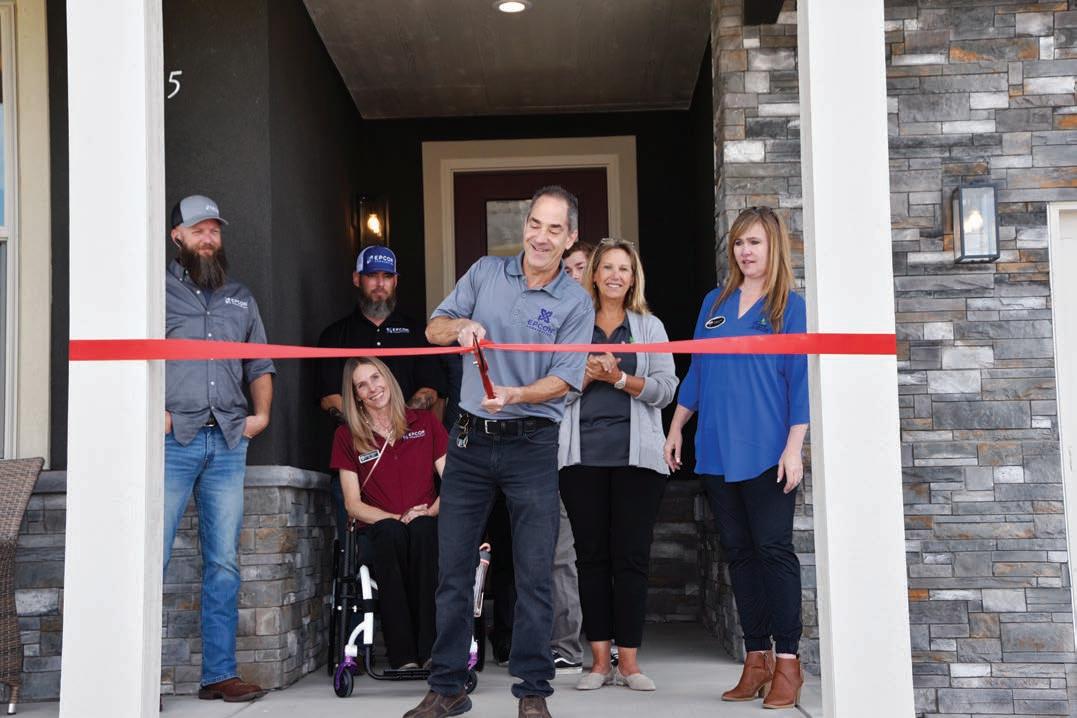
12 minute read
LOCAL
BY BELEN WARD BWARD@COLORADOCOMMUNITYMEDIA.COM

Eastman Properties completed its model home for residents that are 55-years-old and older and celebrated its grand opening on October 21 with a ribbon cutting ceremony.
The new project, The Courtyards at Lupton Village at 207 S Rollie Ave., is the fi rst Colorado project from national homebuilders Epcon, a company that specializes in housing for 55+ buyers.
“After starting my real estate journey, I realized that the 55+ market has been tremendously under-served. I knew there had to be a way to capitalize on this market – and that’s when I found Epcon,” said David Krafsur, owner and managing member of Eastman Properties.
Krafur’s expert knowledge of the baby boomer demographic inspired him to build The Courtyards at Lupton Village, a 27-unit community. Its community is near downtown Fort Lupton, a recreation center, a golf course and a new library. The homes will have open fl oor plans, high ceilings, and room for entertaining.
“David’s unique engineering background and owning his own business make him an ideal Epcon Franchise Builder,” said Paul Hanson, president of Epcon Franchising. “We look forward to leveraging our experience and sharing our substantial knowledge with Eastman Properties to develop their Epcon communities.”
“I thought to myself, I want to do something that makes people happy, and what better way to do that than with beautiful homes with amenities that appeal specifi cally to the Fort Lupton demographic,” Krafsur said.




David Krafsur, with Epcon sta , builders, and Re/Maxx associates, are cutting the ribbon in front of the fi rst model home.
PHOTOS BY BELEN WARD
The community of Fort Lupton gathers to celebrate and tour the inside of the model home.
LIBRARY
Assuming responsibilities
“The main purpose of redrafting the IGA is to have the library assume those responsibilities with the new facility so that the school board isn’t responsible for plowing our snow or janitorial services when it’s not inside of their building,” Library Director Thomas Samblanet said.
In addition to adjusted operations, the library board of trustees wants the updated IGA to include their board as a signee.The school district and city do not plan to include them as an offi cial signee on the agreement.The library board proposed an updated version of the IGA with this change, which would formalize their involvement in operations and decisions as the institution evolves.
“Because we are a joint library, because we are a board of trustees, I feel like we should be a part of the discussion,” a library board member said at an Oct. 12 RE-8 study session. “The IGA is about how the library operates, which is in the purview of the library board.”
In an interview with CCM, Weld RE-8 Superintendent Alan Kaylor said that both attorneys for the city and the school district said the library could not enter into an IGA because it is not a governmental entity.
According to Fort Lupton City Administrator Chris Cross, the current IGA tasks the library board with assisting in adoption and implementation of operating policies and procedures to manage the library. He thinks this advisory role will remain in the updated version.
“They can provide local input and help make the library better,” he said.
During the study session, a library board member advocating for the three-party IGA said the library board was a signee on the 2006 version of the IGA.
Samblanet told CCM he has heard varying legal opinions in regards to the exact limits of governance of a library board. He said this situation is “one of the most confusing situations” he has ever stepped into.
“The thing I want the most at the end of the day is for everyone involved… in this decision-making process to understand just how complicated and nuanced this is,” he said. “I think all the voices in the room have something that are worth contributing, and I really hope that everyone would be willing to listen to each other’s ideas through this negotiation process.”
According to Cross, the city and school board will make fi nal decisions on updates to the IGA.
Samblanet said there will be several steps of drafting and negotiation before an IGA is fi nalized.

Obituaries Have Moved to Page 7
To Place an Obituary Notice Please Visit www.FtLuptonPress.com 303-566-4100 obituaries@coloradocommunitymedia.com
golf courses, refl ect the strains on high-growth Colorado cities confronted by higher water prices and dwindling supply, older collection and treatment systems hitting capacity, and everyday infl ation. Arvada says it is paying 30% more for water treatment chemicals, and triple for piping, amid worldwide price increases.
“Water is a critical resource here,” Castle Rock Water Director Mark Marlowe said. “These are the things we can do to make that resource go further.”
“We are at capacity, and parts of our system are full in places that we expect that growth is going to pay for itself,” said Sharon Israel, Arvada’s director of utilities.
Aurora sent water messages loud and clear over the summer by moving to ban new golf courses and sharply limit the amount of traditional thirsty lawn grass installed in the yards of new homes.
Now comes fast-growing Castle Rock, which Tuesday night was expected to give fi nal passage to a ban on front yard grass in new homes and a limit on backyard grass to 500 square feet. The new rules also demand that developers oversee all water-wise landscaping if they want to qualify for discounts off steep tap fees.
City water agencies are ramping up those tap fees charged to developers to link to local water systems to pay for higher water acquisition and distribution costs amid the historic Western drought. The tap fees have risen so high that homebuilders are arguing — out of self-interest, but also refl ecting concerns of town offi cials — that water fees are a major contributor to the lack of affordable housing on the Front Range.
Castle Rock’s utility system fees for a newly built single-family home in 2023 will be $42,097, up from $37,067 this year. Developers who agree to oversee landscape installation themselves using certifi ed conservation contractors can trim more than $16,000 from that total under the new rules, offi cials said.
Arvada’s vote Monday night boosted charges for water, sewer and stormwater connections that it calls “system development fees” to $54,000, more than double the previous $25,000 fee, according to city offi cials and the Home Builders Association of Metro Denver.
Builders know water conservation is crucial now more than ever, and agree with the gist of the Aurora and Castle Rock initiatives, HBA’s Morgan Cullen said. They did seek concessions, not wanting to be responsible for overseeing all the landscaping.
But the rapid increase in new home tap fees, in Arvada and to a lesser extent in places like Castle Rock, is exacerbating crushing affordability problems for new buyers, Cullen said. “Water is getting prohibitively expensive,” he said. At current median home prices, the rising tap, storm and wastewater fees represent about 10% of the overall price, he noted.
The stress on water resources and homebuyer resources will only worsen. Castle Rock expects to grow from 81,000 people to 140,000 in the next couple of decades. The city wants to cut per capita water use by 18% in the next 10 to 20 years, Marlowe said.
Castle Rock gets its drinking water from a combination of withdrawals from aquifers under Douglas County, which are depleting and can’t continue to be used at current rates, and buying from Denver and Aurora. Water law allows much of Castle Rock’s water to be reused — withdrawals from aquifers and transmountain diversions can be recycled “to depletion.” The town is working on recycling more aquifer water back into the system after it is spread on landscapes and fl ows back to local creeks.
Restricting water use in new development also helps keep costs lower for existing Castle Rock homeowners, Marlowe said, a key consideration as electric, water and other utility rates soar. On a winter day, Castle Rock uses 4 million to 5 million gallons of water, while summer days peak at 19 million gallons. The city must build out enough infrastructure to handle the peaks, and charge ratepayers for the capacity and upkeep.
Avoiding new infrastructure through keeping the summer peaks lower “will help on rates” over the long term, Marlowe said.
Castle Rock calls its alternative home landscaping models “Coloradoscaping,” and Marlowe said such water-saving designs will be part of many new developments up and down the Front Range. “We certainly think it’s a good thing for the state as a whole,” he said.
Arvada’s steep increases to both development fees and rates for existing water and sewer users will shore up existing systems and allow growth that supports future city budgets, council members said in approving the increases unanimously Monday night.
“Development has to pay its own way,” Arvada Mayor and Councilmember Marc Williams said. “We’re not going to do it on the backs of existing ratepayers. Yes, we recognize this is going to have an impact on housing costs.” Like other council members, Williams said Arvada now needs to redouble efforts on both utility support programs for lower-income customers, and creating more affordable housing units.
“We invite all of you to work with us on that,” Councilmember Lauren Simpson told developers and community members in the audience.
“As much as I hate to do it, it’s a necessary evil. I hope this doesn’t deter development in our community,” Councilmember David Jones said.
Developers speaking at Monday night’s public hearing said the connection fees were high, but praised the council for agreeing to delay higher payments until July 2023 to allow them to line up permits and fi nancing before the new fees take effect.
“I hope that with the modifi cation, developers will still see Arvada as a great place to be,” Jones said.
Arvada purchases most of its water from Denver Water. The Jefferson County community is paying for onesixth of the controversial expansion of Denver Water’s Gross Reservoir Dam in Boulder County, and will receive one-sixth of the new water supply from that, Israel said.
The city and consultants spent the past three years studying water supply and capacity for water treatment, stormwater and sewage, Israel said. Council members mentioned their tours of the aging sewage treatment facilities reaching their limits, and having helped neighbors shovel sewage out of basements after the 2013 fl oods on the northern Front Range.
Denver Water, meanwhile, is raising its raw water charges to Arvada by 15%, Israel said. Every stage of utility handling is undergoing massive infl ation, from water cleaning chemicals to pipelines to fuel and equipment. Arvada needs to issue $100 million in bonds for its water and sewage utility systems, and interest rates on that new borrowing will be far higher than the rates contemplated three years ago.
At the same time the new development fees were passed, the council approved a 12.3% increase in existing water rates and a 9.8% boost to sewage rates. Both systems will also charge higher fi xed monthly service fees.
“So all of that together we estimate it would be about $9 more a month for a typical single-family residence,” Israel said. “We are still in the bottom third of the metro area in terms of fees for water and sewer services. So it sounds like a big jump, but it’s a big jump on a relatively smaller number.”
Israel acknowledged Arvada has not made the same push that Castle Rock and Aurora have made to reduce thirsty grass lawns. Landscape watering typically makes up about 50% of municipal water use in arid states that are thick with traditional turf grass. Arvada customers have access to consultation on creating a more water-wise landscape, she said, and the city is gradually installing smart water meters in homes that alert customers to leaks and their overall use.
“We haven’t gone the same route as some other communities,” she said.



A home in Castle Rock that won the town’s Coloradoscape contest in 2020. On Sept. 20, the town council approved a new ordinance requiring new homes have Colora-
doscape front yards and incentivizes limited turf in back yards. PHOTO BY MCKENNA HARFORD
This story is from The Colorado Sun, a journalist-owned news outlet based in Denver and covering the state. For more, and to support The Colorado Sun, visit coloradosun.com. The Colorado Sun is a partner in the Colorado News Conservancy, owner of Colorado Community Media.
PAID ADVERTISEMENT
Don’t overlook importance of cash
If you’re an investor, you no doubt pay a lot of attention to your stocks, bonds and mutual funds. But you shouldn’t forget another key element of your financial strategy: cash.
Cash can help you in several ways. First of all, it’s a good idea to have a few months’ worth of living expenses in cash to pay for unexpected expenses, such as a major home repair.
Also, cash can help you meet short-term savings goals, such as a wedding or a long vacation.
And of course, you’ll need a reasonable amount of cash to meet your everyday spending needs — your mortgage, groceries, and so on.
Finally, you can use some of the cash in your portfolio as part of a systematic strategy in which you place set amounts of money at regular intervals into investments that are appropriate for your goals.
Still, you don’t want to keep so much cash that you underfund your longer-term investments — the ones with the growth potential needed to help you reach your retirement goals.
Put your cash to work for you. By using it wisely, you can add a valuable element to your financial picture.
This article was written by Edward Jones for use by your local Edward Jones Financial Advisor.



